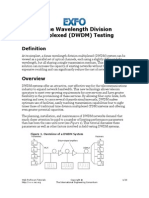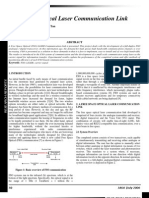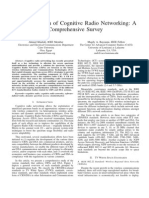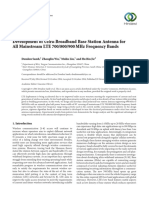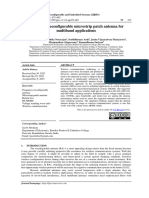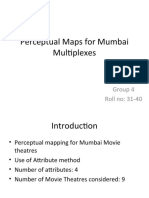Dense Wavelength Division Multiplexed (DWDM) Testing: Figure 1. Overview of A DWDM System
Dense Wavelength Division Multiplexed (DWDM) Testing: Figure 1. Overview of A DWDM System
Uploaded by
Camilo R.Ortega M.Copyright:
Available Formats
Dense Wavelength Division Multiplexed (DWDM) Testing: Figure 1. Overview of A DWDM System
Dense Wavelength Division Multiplexed (DWDM) Testing: Figure 1. Overview of A DWDM System
Uploaded by
Camilo R.Ortega M.Original Title
Copyright
Available Formats
Share this document
Did you find this document useful?
Is this content inappropriate?
Copyright:
Available Formats
Dense Wavelength Division Multiplexed (DWDM) Testing: Figure 1. Overview of A DWDM System
Dense Wavelength Division Multiplexed (DWDM) Testing: Figure 1. Overview of A DWDM System
Uploaded by
Camilo R.Ortega M.Copyright:
Available Formats
Web ProForum Tutorials
http://www.iec.org
Copyright
The International Engineering Consortium
1/19
Dense Wavelength Division
Multiplexed (DWDM) Testing
Definition
At its simplest, a dense wavelength division multiplexed (DWDM) system can be
viewed as a parallel set of optical channels, each using a slightly different light
wavelength, but all sharing a single transmission medium. This new technical
solution can increase the capacity of existing networks without the need for
expensive recabling and can significantly reduce the cost of network upgrades.
Overview
DWDM systems offer an attractive, cost-effective way for the telecommunications
industry to expand network bandwidth. This new technology allows telecom
operators to meet ever-growing requirements for new services and have greater
flexibility in the provision of these services. By allowing fiber-optic links, both
existing and new, to carry several channels simultaneously, DWDM makes
optimum use of facilities, easily reaching transmission capabilities four to eight
times those of traditional time division multiplexed (TDM) systems and offering
even greater potential capacities.
The planning, installation, and maintenance of DWDM networks demand that
much closer attention be paid to a number of limiting performance parameters
than has been the case until now (see Figure 1). This tutorial discusses these
parameters as well as other factors involved in field testing DWDM systems.
Figure 1. Overview of a DWDM System
Web ProForum Tutorials
http://www.iec.org
Copyright
The International Engineering Consortium
2/19
Topics
1. The Need for New Testing Tools
2. Spectral Measurements
3. Parameters to be Measured in the Field
4. Optical Spectrum Analyzer
5. OSA Characteristics
6. Wavelength Meter
7. New Requirements for Traditional Fiber-Optic Test Instruments
8. Characterizing Fiber for DWDM Applications
9. Field Testing DWDM Systems
10. Conclusion
Self-Test
Correct Answers
Glossary
1. The Need for New Testing Tools
Although both designing and implementing DWDM systems calls for
considerably more care than has been needed for conventional systems, by and
large, the skill and capability necessary has increased to a degree: existing
knowledge bases and facilities, with some additional training and upgraded
instrumentation, will meet the challenges that the new technology presents.
However, the same cannot be said for field testing. New parameters must be
measured, and component characteristics once of interest only before installation
must now be verified regularly. In addition, accuracy and stability requirements
reach new levels, and an entirely new dimensionwavelengthmust be
considered. Field test equipment suitable for troubleshooting in single-
wavelength systems cannot cope with these needs. New instrumentation is
urgently required.
Testing and troubleshooting single-wavelength systems in the field can be
accomplished by monitoring a few well-defined parameters. For example, optical
power loss, or attenuation, has always been a key factor in the performance of
fiber-optic links, and portable optical loss test sets have been developed to
measure this loss in the field. Instruments with optical time domain
reflectometric capabilities have been developed to locate faulty elements in a link.
As system sophistication has grown, so has the significance of optical return loss,
especially in the CATV field, where source-laser instability caused by reflected
energy can have serious effects on signal quality. Field instrumentation has been
Web ProForum Tutorials
http://www.iec.org
Copyright
The International Engineering Consortium
3/19
developed to monitor this parameter as well. All this test equipment is still
required in the DWDM environment, but with characteristics adapted to the
much more stringent needs of wavelength division systems.
In the fiber itself, both chromatic and polarization mode dispersion spread signal
pulses and set limits on the transmission capacity, and their effects may be severe
on the transmission signal integrity. New instrumentation capabilities may be
needed to identify the sources of these disturbing influences and ensure that they
do not adversely affect performance.
2. Spectral Measurements
The major new requirement in the test and monitoring of DWDM systems is the
need to characterize components and link accurately as a function of wavelength.
Instrumentation to do so already existsthe optical spectrum analyzer (OSA) has
long been a fixture in network development and test laboratories. Now, however,
similar capabilities must be provided in the field. Capabilities must be usable for
maintenance personnel working in conditions that are very different from those
in the stable, controlled laboratory environment. Major advances in
instrumentation engineering are needed to take measurement capabilities that
were once available only in a laboratory out into the field (see Figure 2).
Figure 2. DWDM Critical System Parameters
3. Parameters to Be Measured in the Field
The core measurement capabilities needed in the spectral domain include the
following:
channel powerOne must be able to measure the optical power in
each channel to verify the equal distribution of power over the
Web ProForum Tutorials
http://www.iec.org
Copyright
The International Engineering Consortium
4/19
bandwidth of the optical amplifiers (EDFAs) that are used in the link
(i.e., to measure the spectral uniformity of the optical power).
channel center wavelength and spacingThe precise value of
the center wavelength of each channel must be measured in order to
detect unacceptable drifts in DFB laser sources.
signal-to-noise ratioThis is one of the most important parameters
to be measured for each channel in a DWDM system, as it is the best
indicator of the overall performance of the channel. The noise
measurement it incorporates must be based on measurements of the
noise floor between channels.
crosstalkThis parameter reveals the level of unwanted signal (noise
plus contribution from other channels) in the passband of the tested
channel. It is awkward to incorporate its measurement into field tests
because it is a two-step operation, but it can be critical.
total optical powerBecause adverse effects of non-linear
phenomena in the optical fiber depend on the total power carried, the
parameter must be measured or calculated by summing the individual
channel powers.
4. The Optical Spectrum Analyzer
Although by its very nature the laboratory-based optical spectrum analyzer meets
the new testing requirement for measurements as a function of wavelength,
present-day OSA versions are entirely unsuited to field use. Large and heavy,
laboratory OSAs are not packaged for portability. The sophisticated optics they
contain make them extremely vulnerable to shock and in frequent need of re-
alignment and re-calibration. Their proper use requires a high degree of operator
skill. All in all, laboratory OSAs are the antithesis of a good candidate for field use
(see Figure 3).
Web ProForum Tutorials
http://www.iec.org
Copyright
The International Engineering Consortium
5/19
Figure 3. Traditional Optical Spectrum Analyzer Design, Single
Pass Monochromater
Producing an OSA that is small, rugged, and reliable enough to be carried about
in the field and to be operated by technicians lacking extensive experience with
laboratory OSAs is a challenge whose resolution involves the following three
steps:
1. eliminating the features and capabilities of laboratory instruments not
required for the maintenance of DWDM networks (e.g., spectral
measurement abilities outside the EDFA wavelength region)
2. selecting and developing an optical configuration that can withstand
shock and operate without the delicate mechanical displacements used
by conventional single-pass and double-pass monochromater designs
(see Figure 4)
Figure 4. Narrowband, Shock-Resistant OSA Design
3. simplifying the traditional, complex, laboratory-oriented user interface
to accommodate the needs of the field operator
Web ProForum Tutorials
http://www.iec.org
Copyright
The International Engineering Consortium
6/19
5. OSA Characteristics
Characteristics essential to a field version of an OSA, while measuring the core
parameters already identified, include the following:
dynamic rangeAn adequate dynamic rangethe ability to measure
weak signals in the presence of strong onesis needed to measure the
power in a strong, non-saturated signal and that of the adjacent noise
floor (in a specified bandwidth). For example, in a system with 100
GHz (0.8 nm) channel spacing, an OSA must be able to measure an
optical signal at a given wavelength and, just 0.4 nm away, an ASE
noise level that may be 30 dB to 35 dB weaker (see Figure 5).
Figure 5. Dynamic Range Calculation for an Optical Spectrum
Analyzer
optical sensitivityThe instrument sensitivitythe lowest signal
level it can quantifyis generally determined by electronic
considerations (the dark current of detectors, noise in detector
preamplifiers, etc.). It must be low enough to permit the measurement
of component insertion loss and assess the signal-to-noise ratio in all
parts of a network.
resolution bandwidthThe resolution bandwidth of an OSA
determines its ability to deal with close optical channel spacing. It is
measured as the width of the response curve at half peak power (i.e., 3
dB down) of the instrument to a monochromatic test signal. This
specification is often called full-width half-maximum (FWHM) (see
Figure 6).
Web ProForum Tutorials
http://www.iec.org
Copyright
The International Engineering Consortium
7/19
Figure 6. Resolution Bandwidth Calculation for an Optical
Spectrum Analyzer
wavelength accuracyThis is without doubt the shortcoming of the
optical spectrum analyzer. Good absolute wavelength accuracy requires
the perfect positioning of the grating, which is difficult to do with
rotational mechanisms. However, the precision of OSAs gives them the
ability to detect unacceptable relative drifts in DFB laser sources.
Outboard calibration options such as acetylene absorption cells can be
used to improve absolute accuracy to a level acceptable for many other
DWDM test applications (see Figure 7).
Figure 7. OSA Absolute Wavelength Accuracy
Although complete redesign of the traditional OSA is needed before its
capabilities can be offered to field personnel faced with the difficult task of
maintaining and troubleshooting DWDM networks, its potential advantages in
measuring appropriate parameters make the OSA the leading candidate to
dominate the DWDM test field. The OSA offers, in a single package, virtually all
the test capabilities needed, but many steps must be taken to simplify the
hardware and make it rugged, as well as to provide the one-button test
procedures, auto-diagnostic functions, and easy-to-follow approaches needed to
Web ProForum Tutorials
http://www.iec.org
Copyright
The International Engineering Consortium
8/19
take its undisputed advantages smoothly to the field, where they are badly
needed.
6. The Wavelength Meter
The interferometer-based wavelength meter is used in the laboratory to make
accurate, repeatable measurements of source wavelengths. Such measurements
are often needed in DWDM systems, in particular to check the center
wavelengths and the drift characteristics of each of the transmitted optical
channels. Although the intrinsic accuracy of about 0.001 nm that such
instruments attain in the laboratory is entirely adequate to characterize DWDM
components, providing comparable capabilities in field instrumentsincluding
such features as internal wavelength-reference sources and fast-fourier transform
(FFT) processing for deconvolutionis a design and engineering challenge of
considerable magnitude (see Figure 8).
Figure 8. Traditional Wavelength Meter Design
Nevertheless, the wavelength meter is expected to be the instrument of choice for
such DWDM tasks as accurately measuring the center wavelengths of distributed
feedback lasers and monitoring how they change with time (both short-term and
long-term), temperature, and other environmental conditions. Among the
characteristics that are particularly important in a field version of a wavelength
meter are the following:
absolute wavelength accuracyThe ability to accurately measure
the absolute wavelength of a channel is the strongest attribute of this
type of instrument. With the help of an interferometer, which is usually
both precise and accurate in wavelength, the absolute accuracy of the
Web ProForum Tutorials
http://www.iec.org
Copyright
The International Engineering Consortium
9/19
wavelength meter should be better than about 0.005 nm, adequate to
locate individual DWDM channel wavelengths.
absolute power accuracyThe ability to measure the exact power
in each DWDM channel is important to verify the power flatness
throughout the link. Using a wavemeter, the actual power in each
channel can be determined through use of the FFT calculation to an
accuracy that is limited by the approximations inherent in that
calculation. The resulting absolute power accuracy will usually be a
little lower than that of the OSA (see Figure 9).
Figure 9. Wavelength Meter Wavelength and Power Accuracy
dynamic rangeThe ability to measure weak signals in the presence
of strong ones, dynamic range is requiredas it is in the OSAto
measure the noise floor in a multichannel transmission system. The
wavelength meter can attain a dynamic range of 20 dB to 25 dB for
characterization of DWDM channels.
number of channelsThe number of channels the instrument can
extract depends on the mechanical precision of the interferometer and
on the extraction capacity of the FFT algorithm used. Forty to a
hundred channels should be attainable, enough to characterize DWDM
systems properly.
The wavelength meter's strength in absolute wavelength measurement enhances
the OSA and is an excellent complementary instrument for the complete
characterization of DWDM systems. Furthermore, certain field operations
determining DFB center wavelengths and troubleshooting lasers, in particular
require the accuracy that the wavelength meter provides.
Once again, the challenge is to modify present wavelength meters, which are
intended for use in the laboratory, to make them suitable for the demanding
DWDM field environment. The new field wavelength meter will have to be rugged
Web ProForum Tutorials
http://www.iec.org
Copyright
The International Engineering Consortium
10/19
and portable and will have to offer simple andto as great a degree as possible
automatic test procedures.
7. New Requirements for Traditional Fiber
Optic Test Instruments
In addition to instrumentation specifically designed for the maintenance of
DWDM systems (i.e., the new OSAs and wavelength meters whose characteristics
have been outlined elsewhere in this tutorial), conventional field installation and
test equipment must also be considered because of the strong influence that some
of the properties of fiber-optic links have on DWDM transmission. Although
many of the basic attributes of these links are independent of the transmission
mode used (TDM or WDM) and can thus be measured using conventional
instruments, a few parameters are critical to proper DWDM operation, and
special care must be taken in selecting field instruments to measure them.
Optical Loss Test Sets (OLTS)
Because of the use of several channels at different, precisely defined wavelengths,
dedicated WDM power meters must be calibrated at specified wavelengths in the
1530 nm to 1565 nm band, in order to measure the power in individual channels
at the output of demultiplexers. Optical loss test sets will also be used at the
wavelengths used for optical supervisory channels (OSC)1480 nm, 1510 nm,
and 1625 nm, depending on the system design. Dedicated DFB light sources will
be needed to verify the loss budget when the fiber is installed. The longest OSC
wavelength, 1625 nm, requires particular attention since this wavelength lies
outside the range in which the fiber or cable manufacturer guarantees the
performance of its product. Optical loss test sets specifically intended for this
wavelength can be expected to reach the market soon.
Optical Time Domain Reflectometer
A clear tendency is emerging in the OTDR world to offer capabilities in the fourth
window spectral region, at 1625 nm. In addition to the ability to test and
troubleshoot the important 1625 nm optical supervisory channel, using this
wavelength presents other important advantages. In particular, in many
circumstances, live fibers may be tested at the 1625 nm wavelength while normal
DWDM transmission continues uninterrupted in the EDFA spectral region.
Because optical losses due to fiber bending are more pronounced at 1625 nm than
at the shorter DWDM operational wavelengths, OTDR testing at the long
wavelength can reveal critical points in the installed fiberplaces where the
performance of the fiber is acceptable at the time of installation but could
degrade over time (see Figure 10).
Web ProForum Tutorials
http://www.iec.org
Copyright
The International Engineering Consortium
11/19
Figure 10. Bending Loss Comparison at 1310 nm, 1550 nm, and
1625 nm
Back Reflection Meter
In a conventional (nonWDM) network, the optical return loss (ORL) can be
determined with a single measurement using a back reflection meter at the
operating wavelength. In DWDM systems there are two possibilities: an
aggregate measure covering the entire wavelength band in use or a detailed one,
giving results for each channel wavelength. Although the first is obviously quicker
to perform and may provide enough information to satisfy a go/no-go acceptance
test, ORL can vary considerably from channel to channel. This ORL variation
with wavelength may be caused by defective Bragg gratings or, more often, from
bad connectors at the output port of a multiplexer or demultiplexer. Excessive
back reflection can cause instability in DFB source lasers, thereby affecting the
overall system performance. As a result, an ability to perform the more complex
wavelength dependent measurement will often be needed.
An aggregate measurement is made with a broadband source and an independent
power meter in the same way the measurement is carried out in a single-
wavelength optical link. The measurement result is a single valuethe total ORL
power at the test point, over the entire transmission spectrum. The value of the
ORL as a function of wavelength is often a more useful parameter intrinsically,
and its determination may be essential if the simpler aggregate test should fail on
a particular link. It is measured using a high-power broadband source, usually an
erbium-amplified spontaneous emission (ASE) source. High power is needed to
provide enough power in each measurement band, which may be as little as 0.1
nm wide, to give an adequate signal-to-noise ratio at the detector for the lowest
ORL of interest. The detector is an optical spectrum analyzer of adequate
resolution and sensitivity. The result, of course, is an individual ORL reading
often just the information needed to guide a troubleshooting sessionfor each
DWDM channel (see Figure 11).
Web ProForum Tutorials
http://www.iec.org
Copyright
The International Engineering Consortium
12/19
Figure 11. Optical Return Loss Spectral Measurement
8. Characterizing Fiber for DWDM
Theory predictsand field experience confirmsthat the characteristics of the
fiber itself can have significant impact on the performance of DWDM networks
and that the particular characteristics which are most important are not
necessarily those of greatest concern in conventional single-wavelength links.
Chromatic Dispersion
Chromatic dispersion, the variation of the index of refraction of the fiber with
wavelength, can be a critical determinant of system performance in DWDM
systems, especially those that use a judiciously selected amount of dispersion to
minimize certain undesirable nonlinear effects in the fiber itself. Its value is
determined during fiber manufacture, however, and few situations have arisen in
which it is necessary to verify this value in the field.
As DWDM systems are operated ever closer to their limits, however, a need is
likely to emerge to verify that this parameter is adequately controlled at every
point in the optical path. The eventual development of field instrumentation to
measure chromatic dispersion is likely, especially if the management of
chromatic dispersion on installed fiber turns out to be more complex than
expected.
Polarization Mode Dispersion
Polarization mode dispersion (PMD), in which various polarization states of the
optical signal propagate at different velocities, is especially difficult to deal with.
Its effects prevent many present-day optical systems from using high-bandwidth
Web ProForum Tutorials
http://www.iec.org
Copyright
The International Engineering Consortium
13/19
transmission equipment meeting 10Gbps OC192 specifications. Since current
state-of-the-art DWDM technology offers eight such OC192 channels, where the
fiber can support the rate, PMD can be a serious limitation to system
performance and to prospects for upgrading that performance.
PMD affects the transmission quality by spreading signal pulses and, therefore,
raising the bit error rate (BER) of the system. It arises in the first place because of
asymmetries in the fiber itself, so the primary remedy must be applied at the
manufacturing level. But the damage does not necessarily end there. During
installation, the fiber can be crushed, kinked, or otherwise overstressed.
Environmental and climatic changes can also affect its circular geometry and
thus worsen its PMD characteristics. Post-installation testing may be needed to
ensure that a network does not overly suffer from PMD and that the installed
facilities can be upgraded to support tomorrow's higher bit rates (see Figure 12).
Figure 12. PMD Effects on System Performance
Second-order PMD, the variation of polarization mode dispersion with
wavelength, is considered to have a negligible effect on network performance.
However, it acts as a completely random contribution to the network's chromatic
dispersion, possibly negating deliberate steps taken in network design to provide
the exact amount of this dispersion to reduce nonlinear disturbances in signal
propagation. Although this parameter bears watching, its long-term importance
cannot yet be predicted.
9. Field Testing DWDM Systems
As previously indicated, the implementation of DWDM transmission systems in
the field on a large scale will have a major impact on each level of installation and
system verification. New skills will have to be developed to face these new
Web ProForum Tutorials
http://www.iec.org
Copyright
The International Engineering Consortium
14/19
challenges, and existing test instrumentation will require adaptation.
Nevertheless, one instrument emerges as the apparent reference DWDM system
characterization toolthe optical spectrum analyzer.
The optical spectrum analyzer is eminently suited to almost all the field testing
needed in DWDM systems: measurements of signal levels, signal-to-noise ratio,
crosstalk as well as channel spacing and stability. The graphic presentation of
modern OSA instruments, clearly showing how the parameter of interest varies
with wavelength, gives an excellent overview of many of the phenomena crucial to
the proper operation of DWDM networks and valuable clues for the subsequent
investigation of any problems that the measurement might reveal. Nevertheless,
in many contexts it offers too much information and often not the specific
information the field maintainer or troubleshooter needs. Operating and readout
procedures and tools must be greatly simplified from those appropriate to
laboratory OSAs if the instrument is to be cost-effective in the field (see Figure
13).
Figure 13. DWDM Test Instrumentation
However, to complement OSA testing in the field, center wavelengths must be
accurately measured. This parameter can be important, especially if the system
under study is part of a larger one whose standards must be respected. Other
instrumentation offering more accurate wavelength calibrationa wavelength
meter, most likelyis also needed for such operations as the measurement of
DFB characteristics.
10. Conclusion
Any telecommunications service provider who operates or installs DWDM
systems must meet testing requirements well beyond those needed for older-
generation equipment and must be prepared to perform sophisticated testing in
the field on existing lines and equipment. In particular, the spectral dimension,
once of interest only to development laboratories, now must be considered
Web ProForum Tutorials
http://www.iec.org
Copyright
The International Engineering Consortium
15/19
throughout the life cycle of a network, from planning through installation to
routine maintenance.
These new requirements will inevitably lead to the development of new field test
instruments tailored for use in DWDM systems. The core of this new
instrumentation suitethe reference test instrumentis likely to be the optical
spectrum analyzer because of its ability to perform most of the measurements
needed for system characterization, maintenance, and troubleshooting.
The mini optical time domain reflectometer, or miniOTDR, which brought
sophisticated time domain reflectometry capabilities to field maintainers of fiber-
optic systems, was developed over several years with very close, continual
attention to the real needs of field users. The development of a field-ready mini
OSA should follow a similar path.
Self-Test
1. The introduction of DWDM technology is attractive because _________.
a. it is a cost-effective way to increase the transmission system bandwidth
b. it will one day replace TDM technology
2. New testing tools are required for DWDM testing because __________.
a. transmission rates are too high for actual testing instruments
b. DWDM transmission brings a new spectral dimension into play
3. Channel center wavelength is an important parameter because __________.
a. DWDM systems are precisely tuned for defined and dedicated
wavelengths
b. it will have a major impact on the loss budget
4. Optical signal-to-noise ratio is _________.
a. a good indication of the power loss in the system
b. the best indicator of a channel's overall performance
5. The dynamic range of an optical spectrum analyzer is __________.
a. the ability to measure a weak signal in the presence of or next to a
strong one
Web ProForum Tutorials
http://www.iec.org
Copyright
The International Engineering Consortium
16/19
b. the indication of the optical spectrum analyzer's distance range
6. The redesigned field optical spectrum analyzer is __________.
a. the leading candidate for DWDM transmission field testing
b. a new instrument that is similar to the lab optical spectrum analyzer
7. The strength of the multiwavelength meter is ________.
a. its capacity to measure optical signal-to-noise ratio
b. its ability to measure a wavelength with very good absolute accuracy
8. An optical time domain reflectometer will ____________.
a. no longer be used to test DWDM transmission systems
b. have to be adapted to the new DWDM reality
9. Chromatic dispersion has a major affect on DWDM system performance
because _____________.
a. it impacts the loss budget of the system
b. it can have an impact on the four-wave mixing phenomenon
10. Polarization mode dispersion is ____________.
a. no longer a problem in DWDM systems
b. a phenomenon that may impact DWDM system performances at high
bit rates
Correct Answers
1. The introduction of DWDM technology is attractive because ___________.
a. it is a cost-effective way to increase the transmission system
bandwidth
b. it will one day replace TDM technology
2. New testing tools are required for DWDM testing because __________.
a. transmission rates are too high for actual testing instruments
Web ProForum Tutorials
http://www.iec.org
Copyright
The International Engineering Consortium
17/19
b. DWDM transmission brings a new spectral dimension into
play
3. Channel center wavelength is an important parameter because __________.
a. DWDM systems are precisely tuned for defined and dedicated
wavelengths
b. it will have a major impact on the loss budget
4. Optical signal-to-noise ratio is ____________.
a. a good indication of the power loss in the system
b. the best indicator of a channel's overall performance
5. The dynamic range of an optical spectrum analyzer is _____________.
a. the ability to measure a weak signal in the presence of or next
to a strong one
b. the indication of the optical spectrum analyzer's distance range
6. The redesigned field optical spectrum analyzer is __________.
a. the leading candidate for DWDM transmission field testing
b. a new instrument that is similar to the lab optical spectrum analyzer
7. The strength of the multiwavelength meter is ___________.
a. its capacity to measure optical signal-to-noise ratio
b. its ability to measure a wavelength with very good absolute
accuracy
8. An optical time domain reflectometer will _____________.
a. no longer be used to test DWDM transmission systems
b. have to be adapted to the new DWDM reality
9. Chromatic dispersion has a major affect on DWDM system performance
because ______________.
a. it impacts the loss budget of the system
b. it can have an impact on the four-wave mixing phenomenon
Web ProForum Tutorials
http://www.iec.org
Copyright
The International Engineering Consortium
18/19
10. Polarization mode dispersion is ______________.
a. no longer a problem in DWDM systems
b. a phenomenon that may impact DWDM system performances
at high bit rates
Glossary
AFR
absolute frequency reference
ASE
amplified spontaneous emission
BER
bit error ratio
DFB
distributed feedback
EDFA
erbium doped fiber amplifier
FWM
four wave mixing
MPI
multiple path interference
MPI R
main path interface at the receiver
MPI S
main path interface at the transmitter
MWM
multiwavelength meter
NF
noise figure
OA
optical amplifier
Web ProForum Tutorials
http://www.iec.org
Copyright
The International Engineering Consortium
19/19
OD
optical demultiplexer
OEO
optical electrical optical converter
OM
optical multiplexer
OSC
optical supervisory channel
OSNR
optical signal-to-noise ratio
PMD
polarization mode dispersion
RX
optical receiver
SDH
synchronous digital hierarchy
SNR
signal-to-noise ratio
SPM
self phase modulation
SBS
stimulated brillouin scattering
STM N
synchronous transport module Level N
TDM
time division multiplexing
TX
optical transmitter
WDM
wavelength division multiplexing
XPM
cross-phase modulation
You might also like
- Kenny Burrell-Soul Lament - Guitar TabDocument7 pagesKenny Burrell-Soul Lament - Guitar TabNate Courcy100% (2)
- Concise Guide to OTN optical transport networksFrom EverandConcise Guide to OTN optical transport networksRating: 4 out of 5 stars4/5 (2)
- Ultrasonic Inspection of Pressure Vessel Construction Welds Using Phased ArraysDocument17 pagesUltrasonic Inspection of Pressure Vessel Construction Welds Using Phased ArraystbmariNo ratings yet
- Structural Bolting Handbook-Torque MERDocument1 pageStructural Bolting Handbook-Torque MERCamilo R.Ortega M.No ratings yet
- Orientalism in MusicDocument28 pagesOrientalism in MusicSam100% (1)
- DWDM TestDocument20 pagesDWDM TestPasham ShivaNo ratings yet
- Chapter 08 - TDM, WDM, and CDM SystemsDocument58 pagesChapter 08 - TDM, WDM, and CDM SystemsSnehasis Hota100% (1)
- Optical Ring Architecture Using 4-Nodes WDM Add/Drop Multiplexer Based SSMFDocument3 pagesOptical Ring Architecture Using 4-Nodes WDM Add/Drop Multiplexer Based SSMFDayannaNo ratings yet
- Jon T. Adams: Zigbee Wireless Technology and The Ieee 802.15.4 Radio - Enabling Simple Wireless 2. IEEE 802.15.4 STANDARDDocument5 pagesJon T. Adams: Zigbee Wireless Technology and The Ieee 802.15.4 Radio - Enabling Simple Wireless 2. IEEE 802.15.4 STANDARDSathisha BMNo ratings yet
- Getting Started With A Radio DesignDocument13 pagesGetting Started With A Radio Designviatr0nicNo ratings yet
- PC 2 PC Laser Communication SystemDocument3 pagesPC 2 PC Laser Communication SystemMamun LimonNo ratings yet
- Future Wireless Systems: Uwb, 60Ghz, and Cognitive RadiosDocument4 pagesFuture Wireless Systems: Uwb, 60Ghz, and Cognitive Radiosmarcelonog29No ratings yet
- Title: 100G Coherent System Interoperability: Paper TypeDocument11 pagesTitle: 100G Coherent System Interoperability: Paper Typescribd01No ratings yet
- Software Defined Radio Implementation in 3GPP Systems: January 2015Document6 pagesSoftware Defined Radio Implementation in 3GPP Systems: January 2015rodrigosp0007No ratings yet
- DWDM Technical ReportDocument25 pagesDWDM Technical ReportTareq QaziNo ratings yet
- Foc 10 31-08-23Document26 pagesFoc 10 31-08-23Haardik DasilaNo ratings yet
- Cognitive Radio Experiments Using Reconfigurable BEE2: Artem Tkachenko, Danijela Cabric, and Robert W. BrodersenDocument5 pagesCognitive Radio Experiments Using Reconfigurable BEE2: Artem Tkachenko, Danijela Cabric, and Robert W. BrodersenAditi JainNo ratings yet
- 609C306C-CB89-4A6B-BA11-C50FFB5CF71DDocument13 pages609C306C-CB89-4A6B-BA11-C50FFB5CF71DmasoodalamsNo ratings yet
- Development of Ultra-Wideband AntennasDocument10 pagesDevelopment of Ultra-Wideband Antennasa.zitouniNo ratings yet
- 15 04 0662-02-004a Channel Model Final Report r1Document40 pages15 04 0662-02-004a Channel Model Final Report r1Alex Samuel Ludeña HuamaniNo ratings yet
- 4 - Measurement in A DWDM SystemDocument10 pages4 - Measurement in A DWDM SystemAnonymous 5Pzs8gpVQNo ratings yet
- CRN Standard SurveyDocument8 pagesCRN Standard Surveynassr_ismailNo ratings yet
- Assignment OFC ECDocument6 pagesAssignment OFC ECYash AwasthiNo ratings yet
- 0final GRSLpaper PDFDocument6 pages0final GRSLpaper PDFКираNo ratings yet
- The Evolution of Optical Fibre Communication SystemsDocument13 pagesThe Evolution of Optical Fibre Communication SystemsKuldeep SharmaNo ratings yet
- 252 - A - Distributed - FMCW - Radar - System - Based - On - Fiber-Optic - Links - For - Small - Drone - DetectionDocument8 pages252 - A - Distributed - FMCW - Radar - System - Based - On - Fiber-Optic - Links - For - Small - Drone - DetectionA A Mahmoud YolaNo ratings yet
- Ultra-Wideband Technology For Short-Range, High-Rate Wireless CommunicationsDocument42 pagesUltra-Wideband Technology For Short-Range, High-Rate Wireless Communicationskartheedhanya008No ratings yet
- Tunable Laser Technology: Technical Seminar-IDocument15 pagesTunable Laser Technology: Technical Seminar-IYemula Ajay100% (2)
- Imran 2012Document28 pagesImran 2012Shaik KareemullaNo ratings yet
- Research ArticleDocument11 pagesResearch ArticleMahesh A BirariNo ratings yet
- Cognitive Radio Applications of Spectrum Occupancy in HILLAH-IRQ Measurement and AnalysisDocument7 pagesCognitive Radio Applications of Spectrum Occupancy in HILLAH-IRQ Measurement and AnalysisOpen Access JournalNo ratings yet
- ROADM Networks Enable Adding New Services Without Redesign or Major Changes To NetworkDocument3 pagesROADM Networks Enable Adding New Services Without Redesign or Major Changes To NetworkDo Xuan HuuNo ratings yet
- 0305 SPPDocument22 pages0305 SPPMohammad FarookNo ratings yet
- Performance Analysis of WDM/SCM System Using EDFADocument5 pagesPerformance Analysis of WDM/SCM System Using EDFAeditor_ijarcsseNo ratings yet
- Chapter Three Performance Analysis of An Opticalcross Connect at DWDM SystemDocument8 pagesChapter Three Performance Analysis of An Opticalcross Connect at DWDM SystemYosef KirosNo ratings yet
- Amplifiers For The MassesDocument8 pagesAmplifiers For The Massesmaxwell_eulerNo ratings yet
- Utl DWDM 10G BG25346351Document6 pagesUtl DWDM 10G BG25346351UjlfoDibnvbiNo ratings yet
- Bjornson 14Document28 pagesBjornson 14elhamNo ratings yet
- Field-Trials With Adaptive AntennasDocument9 pagesField-Trials With Adaptive AntennasMohammad ImranNo ratings yet
- DAS RF EssentialsDocument3 pagesDAS RF Essentialsluisalonzo1692No ratings yet
- Dynamic Spectrum AllocationDocument4 pagesDynamic Spectrum AllocationijsretNo ratings yet
- "Guidelines To Low Cost Wireless System Design": Frank Karlsen - RF Designer, Wireless Communications, Nordic VLSI ASADocument15 pages"Guidelines To Low Cost Wireless System Design": Frank Karlsen - RF Designer, Wireless Communications, Nordic VLSI ASAdeyavik2013No ratings yet
- SAR With Digital Beamforming On Receive Only: Manvan - Younis@etec - Uni-Karlsruhe - deDocument3 pagesSAR With Digital Beamforming On Receive Only: Manvan - Younis@etec - Uni-Karlsruhe - defelipemaderoNo ratings yet
- Tutorial Sheet SampleDocument1 pageTutorial Sheet SamplePavan KhetrapalNo ratings yet
- A Nobel Approach For Entropy Reduction of Wireless Sensor NetworksDocument5 pagesA Nobel Approach For Entropy Reduction of Wireless Sensor NetworksEditor IJRITCCNo ratings yet
- Cognitive Radio System Analysis Using MATLABDocument4 pagesCognitive Radio System Analysis Using MATLABKennedy RonohNo ratings yet
- Frequency Reconfigurable Microstrip Patch Antenna For Multiband ApplicationsDocument11 pagesFrequency Reconfigurable Microstrip Patch Antenna For Multiband ApplicationsIJRES teamNo ratings yet
- Techniques - For - Precise - Interference Measurements in The Field - AgilentDocument14 pagesTechniques - For - Precise - Interference Measurements in The Field - AgilentPedro PrietoNo ratings yet
- JDSU Fibercharacterization Poster October2005Document1 pageJDSU Fibercharacterization Poster October2005Amit SwarNo ratings yet
- 123456finalDocument84 pages123456finalashwin semwalNo ratings yet
- Monopol AntennaDocument5 pagesMonopol Antennaia874046No ratings yet
- A Review of Full-Duplex WDM Rof Architectures: Muhammad Haider Raza, Kamran Zaidi, S.M.H ZaidiDocument11 pagesA Review of Full-Duplex WDM Rof Architectures: Muhammad Haider Raza, Kamran Zaidi, S.M.H ZaidiasharspillaiNo ratings yet
- Radio Over Fiber: Future Technology of CommunicationDocument5 pagesRadio Over Fiber: Future Technology of CommunicationPobu PopoNo ratings yet
- Phase Array Ultrasonic PrincipleDocument13 pagesPhase Array Ultrasonic PrinciplealexmontellNo ratings yet
- Research Article On Path Tracing Scheme in Optical NetworkingDocument4 pagesResearch Article On Path Tracing Scheme in Optical NetworkingShanu BangerNo ratings yet
- J - 2012 - System Integration and Radiation Pattern Measurements of A Phased Array Antenna Employing An Integrated Photonic Beamformer For Radio Astronomy ApplicationsDocument14 pagesJ - 2012 - System Integration and Radiation Pattern Measurements of A Phased Array Antenna Employing An Integrated Photonic Beamformer For Radio Astronomy ApplicationsDr. Md. Rezaul Hoque Khan, Prof., EEENo ratings yet
- Bab II ContentsDocument31 pagesBab II ContentspujiedrianyNo ratings yet
- LASER CommunicationDocument16 pagesLASER CommunicationarjunknarayanNo ratings yet
- WSN Unit 2Document14 pagesWSN Unit 2Sandeep Kumar MekapothulaNo ratings yet
- Radio Path Prediction Software: For Command and Control Scenario Developers Reference# C-168, Michael ShattuckDocument16 pagesRadio Path Prediction Software: For Command and Control Scenario Developers Reference# C-168, Michael ShattuckWonSoon KimNo ratings yet
- Metering Article Dec06Document3 pagesMetering Article Dec06SujokoTeeNo ratings yet
- Ijetr022655 PDFDocument10 pagesIjetr022655 PDFerpublicationNo ratings yet
- PD Nemo Analyze 5.13Document22 pagesPD Nemo Analyze 5.13Camilo R.Ortega M.No ratings yet
- BTS3900 WCDMA Site Maintenance Guide (V200 - 07)Document46 pagesBTS3900 WCDMA Site Maintenance Guide (V200 - 07)Apisit KaeokhamNo ratings yet
- Wireless Local Loop (WLL) : Web Proforum Tutorials The International Engineering Consortium 1/18Document18 pagesWireless Local Loop (WLL) : Web Proforum Tutorials The International Engineering Consortium 1/18Camilo R.Ortega M.No ratings yet
- Wireless Application Protocol (Wap) : Web Proforum Tutorials The International Engineering Consortium 1/15Document15 pagesWireless Application Protocol (Wap) : Web Proforum Tutorials The International Engineering Consortium 1/15Camilo R.Ortega M.No ratings yet
- Structured Cabling System (SCS) : Web Proforum Tutorials The International Engineering Consortium 1/19Document19 pagesStructured Cabling System (SCS) : Web Proforum Tutorials The International Engineering Consortium 1/19Camilo R.Ortega M.No ratings yet
- Signaling System 7 (Ss7) : Web Proforum Tutorials The International Engineering Consortium 1/29Document29 pagesSignaling System 7 (Ss7) : Web Proforum Tutorials The International Engineering Consortium 1/29Camilo R.Ortega M.No ratings yet
- Internet Ready BuildingsDocument23 pagesInternet Ready BuildingsCamilo R.Ortega M.No ratings yet
- Fundamentals of TelecommDocument26 pagesFundamentals of TelecommCamilo R.Ortega M.No ratings yet
- Assignment2 SolutionDocument22 pagesAssignment2 Solutionyamen.nasser7No ratings yet
- RevisionDocument9 pagesRevisionHuế NgôNo ratings yet
- Medea Announcement Final - EmbargoDocument3 pagesMedea Announcement Final - EmbargoMichael ApplerNo ratings yet
- Actividades-Explicaciones y Ejercicios PDFDocument25 pagesActividades-Explicaciones y Ejercicios PDFProfeta Zoraida CaicedoNo ratings yet
- SynopsisDocument7 pagesSynopsisLalit AdityaNo ratings yet
- IT Phy F5 Topical Test 3 (BI)Document10 pagesIT Phy F5 Topical Test 3 (BI)rospazitaNo ratings yet
- Terry Theme From LimeLight For DuetDocument4 pagesTerry Theme From LimeLight For DuetPatrikas KingNo ratings yet
- Farewell ScriptDocument9 pagesFarewell ScriptKaranvir Singh 6No ratings yet
- Moon LandingDocument29 pagesMoon LandingRam0% (1)
- Barry (TV Series)Document16 pagesBarry (TV Series)Giovanni Esteban0% (1)
- A High-Dynamic-Range MF - HF Receiver Front EndDocument13 pagesA High-Dynamic-Range MF - HF Receiver Front EndandrewczoneNo ratings yet
- Perceptual Map 31-40Document7 pagesPerceptual Map 31-40kapoorparamNo ratings yet
- Joko KendilDocument3 pagesJoko Kendilpakde baeNo ratings yet
- Smokestack Lightning PDFDocument1 pageSmokestack Lightning PDFManuel Alejandro Rodriguez MadrigalNo ratings yet
- Ra 3846 PDFDocument3 pagesRa 3846 PDFJohn HammerlockNo ratings yet
- Zaha hadid-THE PEAKDocument6 pagesZaha hadid-THE PEAKkienviet100% (2)
- How-Well-Does-The-Larynx-Canal-Match-The-Ear-Canal - Ingo Titze & Brad StoryDocument4 pagesHow-Well-Does-The-Larynx-Canal-Match-The-Ear-Canal - Ingo Titze & Brad StoryVusala HasanovaNo ratings yet
- Indicação de CaptadorDocument5 pagesIndicação de CaptadorenioNo ratings yet
- Kodak Min-R Mammography Processor: Diagnostics For The Service Code: 3752Document18 pagesKodak Min-R Mammography Processor: Diagnostics For The Service Code: 3752Camila LopezNo ratings yet
- Ticket-In W2 2020-1Document1 pageTicket-In W2 2020-1Laura Valentina MancholaNo ratings yet
- Unit 3 Grammar ReviewDocument10 pagesUnit 3 Grammar ReviewYenifer PerezNo ratings yet
- Benny Goodman-Memories: Alto Saxophone 1 Band ConcertDocument4 pagesBenny Goodman-Memories: Alto Saxophone 1 Band ConcertMaestro Valdyr FilhoNo ratings yet
- IES - Electronics Engineering - Control System PDFDocument66 pagesIES - Electronics Engineering - Control System PDFRod S Pangantihon Jr.No ratings yet
- Vastutimes November 2011Document8 pagesVastutimes November 2011ramachariNo ratings yet
- Symmetry As A Compositional Determinant Index & AbstractDocument2 pagesSymmetry As A Compositional Determinant Index & AbstractsertimoneNo ratings yet
- Airtel Atp FormDocument18 pagesAirtel Atp FormCHYKEROYNo ratings yet
- RHCP Sheet MUsicDocument11 pagesRHCP Sheet MUsicdsonger16_9304039280% (1)
- General Physics IiDocument9 pagesGeneral Physics IiJosh Benedict BaromanNo ratings yet






